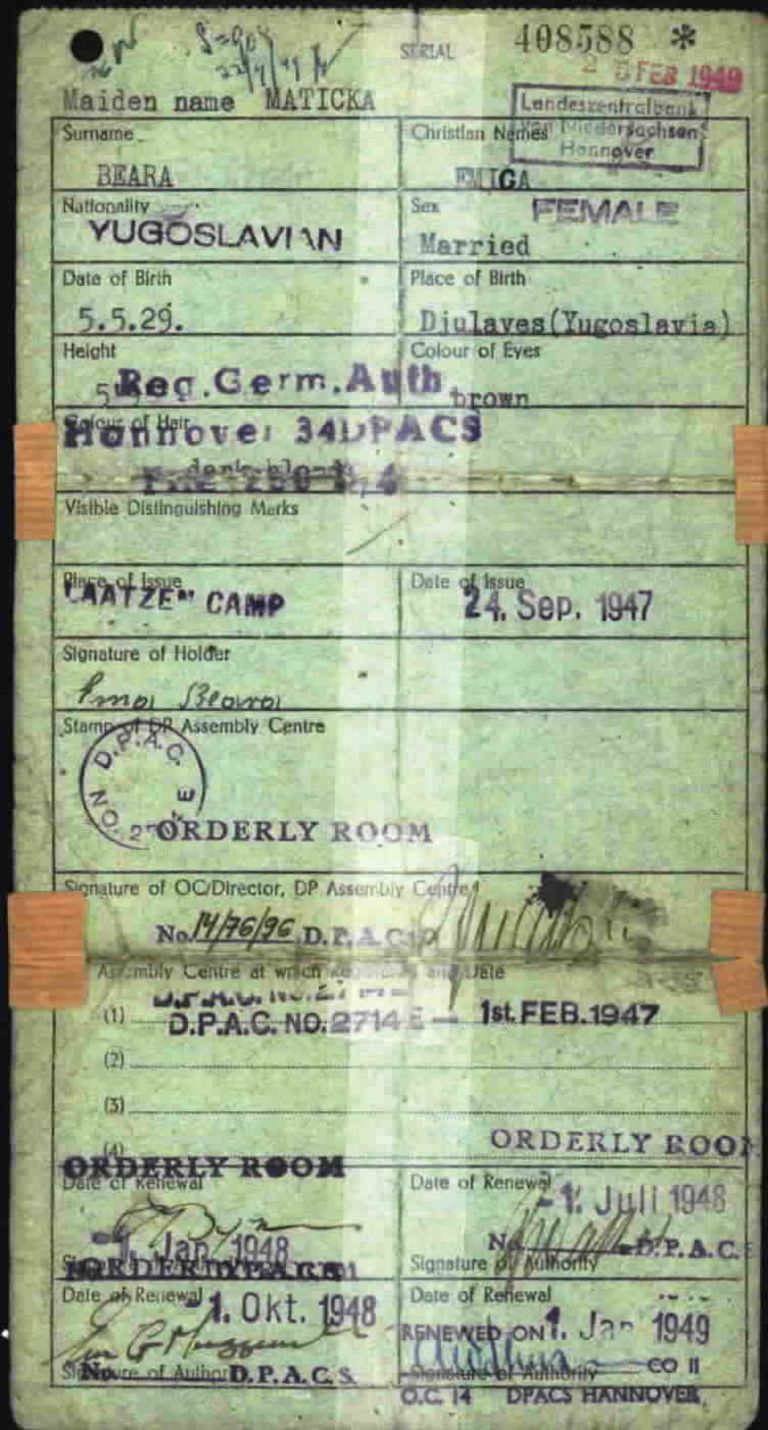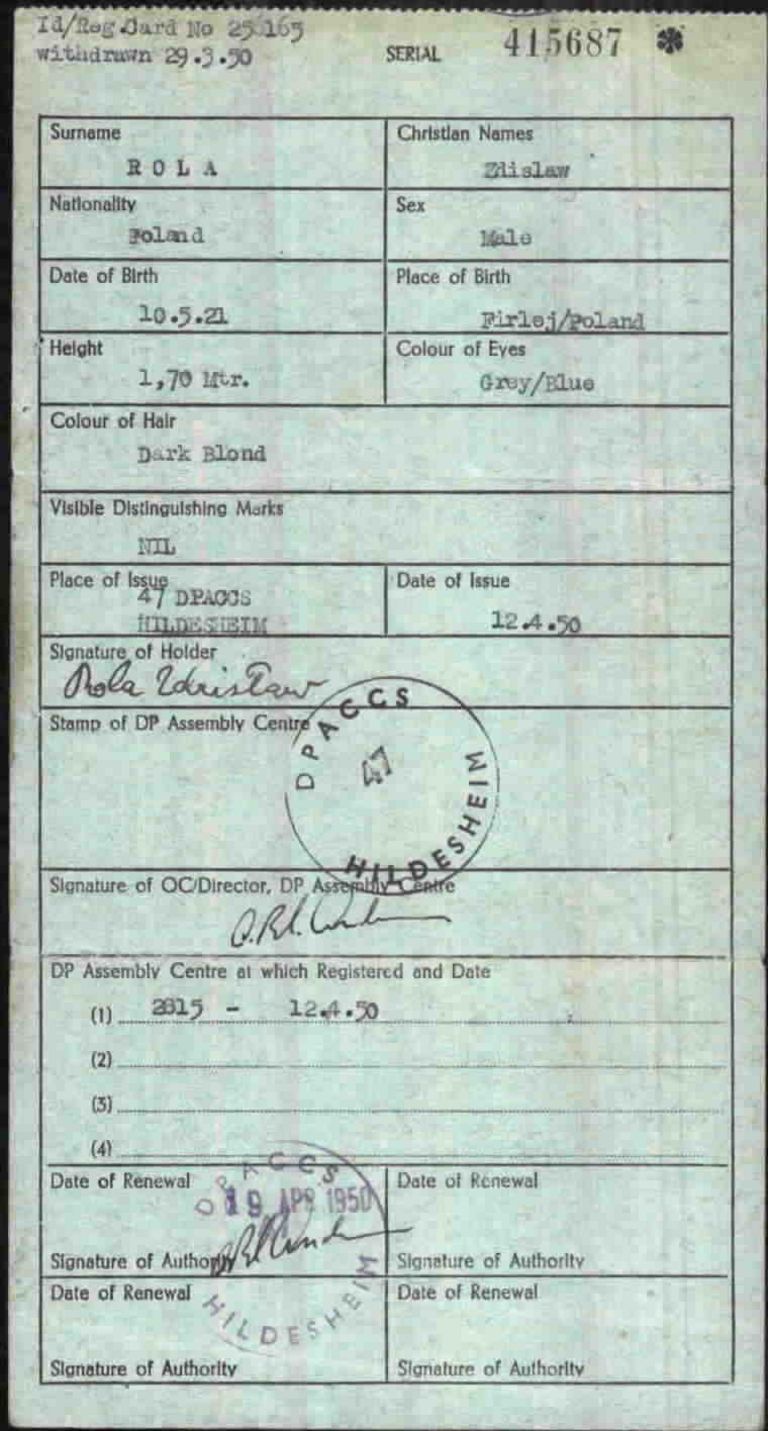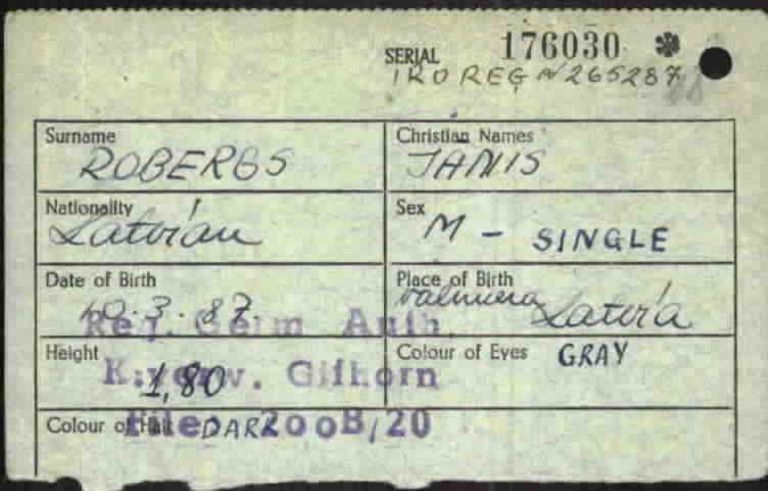Page of
Page/
- Reference
- Intro


This identity card was issued to DPs in the British occupation zone so they could show that they had DP status. UNRRA screened all residents of the camps in the occupation zone to ensure that identity cards were only given to eligible DPs. In order to be eligible, DPs had to fulfill the requirements specified by UNRRA and the British military government.
The identity cards all look very similar, regardless of which DP camp the person was living in. The stamps are the main difference: Since the identity card had to be renewed every three months, some cards are so covered with stamps that they are nearly illegible.
This identity card was issued to DPs in the British occupation zone so they could show that they had DP status. UNRRA screened all residents of the camps in the occupation zone to ensure that identity cards were only given to eligible DPs. In order to be eligible, DPs had to fulfill the requirements specified by UNRRA and the British military government.
The identity cards all look very similar, regardless of which DP camp the person was living in. The stamps are the main difference: Since the identity card had to be renewed every three months, some cards are so covered with stamps that they are nearly illegible.
Questions and answers
-
Where was the document used and who created it?
The responsible UNRRA employees and military government representatives in the British occupation zone – as in the other occupation zones – faced a situation in which people who were not actually eligible to receive care were living in DP camps. The authorities therefore carried out screenings to determine who was an eligible DP. People who met all of the criteria for DP status were given a DP identity card. This was issued by the military government, officially known as the Control Commission for Germany (British Element), or CCG(BE) for short. In the camps, UNRRA and later IRO employees renewed the identity cards that the DPs carried with them.
- When was the document used?
On October 14, 1946, UNRRA ordered the screening of all DPs in the British occupation zone. The earliest identity card found so far is dated February 1947, at which point the screenings had ended. It is not yet possible to say how long the identity cards were used. However, some of the cards preserved in the Arolsen Archives were issued in early 1950.
- What was the document used for?
At the end of the war, military units and UNRRA employees did not screen people but instead simply registered everyone who reported to them as a DP. Careful screening would only have delayed their planned repatriation, or the return of millions of people to their countries of origin. From 1946, however, the situation looked different: The DPs who remained behind had to be housed in camps for longer periods of time, and since many of them refused to be repatriated, new arrangements had to be made for them. To ensure that only eligible DPs received assistance, the military governments conducted screenings together with UNRRA.
These screenings took place in all three Western occupation zones. In the British zone, UNRRA ordered screenings from October 1946. UNRRA teams used questionnaires to review the residents of the 130 camps in the British occupation zone. Since all DPs had to be registered in camps in the British zone – unlike in the US zone, for example, where there were also free-living DPs residing in private accommodations – all of them were screened. In cases of doubt, the decision on someone’s DP status was handed over to one of the nine regional screening boards. These boards were made up of UNRRA employees and representatives of the military government known as the CCG(BE). National liaison officers could also be consulted if there were questions about a person’s nationality. People who successfully passed the screening were issued an identity card that proved they were a DP. If someone did not meet the requirements for DP status – perhaps because they had collaborated with the Nazis or only arrived in the British zone after the cutoff date of June 30, 1946 – the British military expelled them from the camp.
The identity card issued to the DPs was valid for three months, but it could be renewed with a stamp. New identity cards were issued even long after the screenings had ended in February 1947, but it is not clear what the process was for issuing these later documents.
- How common is the document?
Based on the figures reported by historian Wolfgang Jacobmeyer, it is possible to calculate how many DP identity cards must have been issued in the British occupation zone. Of the around 177,800 DPs screened by February 1947, only 10 percent were not granted DP status. Since the rest would have been eligible DPs, there must have been nearly 160,000 DP identity cards. However, it is not possible to say how many of these cards have been preserved in the Arolsen Archives. ITS employees filed the identity cards following an alphabetical-phonetic system together with other documents in the postwar card file (Nachkriegszeitkartei, Collection 3.1.1.1). This made it easier to search for references to people, but it also means there is no way of knowing how common the DP identity cards are. But in the near future, modern computer technology will find the answer: clustering techniques will make it possible to identify the DP identity cards and other types of documents.
- What should be considered when working with the document?
Various DP identity cards were used at different times in the individual occupation zones. In the British zone, what were known as PWX/DP Registration/Identity Cards were used. The IRO identity card, by contrast, was the successor to the D.P. identification card previously issued by UNRRA. Both cards were only used in the US occupation zone. In the French zone, the military administration issued a Carte d’identité de Personnes Déplacées. Although the cards were issued by different offices, they all served the same purpose: to identify DPs as DPs.
The screenings conducted from 1946 onward were clearly the trigger for producing identity cards in the British zone, but there are still many questions about the exact process for issuing the cards. It is also not known when and why the DPs gave back their identity cards so that they could ultimately make their way to the ITS, the predecessor to the Arolsen Archives. Unlike the DP identity card in the US zone, for example, no instructions have been found for how the identity cards were to be issued in the British zone. If you know of such instructions from UNRRA or the military government, please sent an email to eguide@arolsen-archives.org.
Variations
Help for documents
About the scan of this document <br> Markings on scan <br> Questions and answers about the document <br> More sample cards <br> Variants of the document



